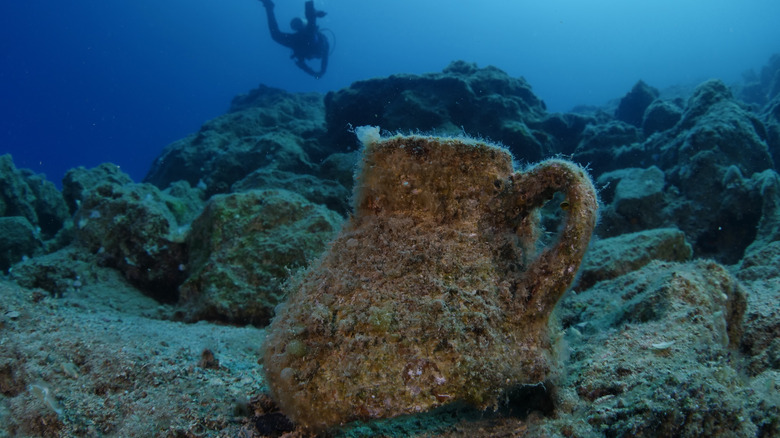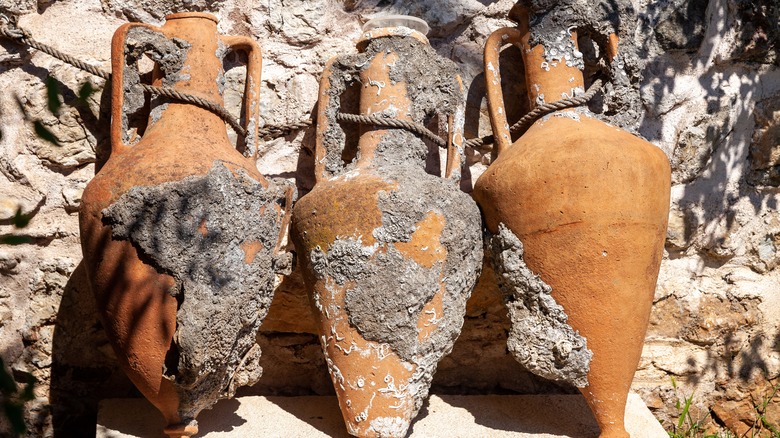The Mysterious Bay Of Jars Explained
In October 1982, an American marine archaeologist and treasure hunter named Robert Marx dived into Brazil's Guanabara Bay, an oceanic body of water on the coast of Rio de Janeiro now known as the "Bay of Jars." What he discovered would make headlines: A number of heavily barnacled but intact clay pots that Marx identified as "amphorae" (via People). The ancient Romans used them as receptacles on long sea voyages, and they were typically found during excavations of shipwrecks that had laid dormant at the bottom of the sea bed for thousands of years.
According to People, the presence of the jars would seemingly have profound repercussions for South American history, suggesting that rather than being first being discovered by the Portuguese explorer Pedro Alvares Cabral in 1500, the first Europeans to arrive on the continent did so some 3,200 years prior — and those that did were in fact of Roman origin.
Marx shared photographs of his discoveries with marine archeologists in America, who agreed that the jars did indeed seem to be of Roman origin. Marx claimed: "If authentic, it would be one of the most important discoveries in the field of marine archaeology." In a report on the discovery published in The New York Times, Marx postulated that the artifacts may have been carried on a Roman ship that had been "blown off course." But not everyone was as willing as Marx to promote the mysterious discovery of Roman amphorae in Guanabara Bay.
The Bay of Jars: a government cover-up?
The fact is, Robert Marx wasn't the first diver to discover mysterious amphorae in the water around Rio de Janeiro. According to The New York Times, two such jars were originally discovered in the bay by a diver named Jose Roberto Teixeira as early as 1976. It was Teixeira who first informed Marx of the location of the jars, which local fishermen had encountered numerous times after snagging them with their fishing nets.
But Brazilian officials make no steps to investigate the finds or amplify what the discovery might mean in terms of the nation's history. Marx argued that the next step in the excavation of the site would be to hunt for the existence of a Roman shipwreck, which would provide overwhelming evidence for his theory. But Marx's investigation went no further. In fact, he later accused the Brazilian government of taking definitive steps to suppress the presence of the jars in the bay.
Per The New York Times, Marx claimed that the Brazilian Navy had prevented him from uncovering any more artifacts by dumping boatloads of silt in Guanabara Bay, instigating a ban on diving in the area, and prohibiting the treasure hunter from reentering Brazil.
How the jars really appeared in the bay
Robert Marx was adamant that officials had been keen to suppress his claim that ancient Romans were the first Europeans to arrive in South America. But the truth as to why his discovery was given short shrift is more prosaic than that of an orchestrated cover-up in the name of preserving Brazil's Portuguese heritage.
As The New York Times explains, while Brazil vehemently denied ever dumping any silt in Guanabara Bay, the reason behind its ban on underwater exploration — and on Marx's excavation of Brazilian waters in particular — was due to charges made against Marx concerning the removal of Brazilian artifacts (like gold coins) from the country and their subsequent sale at auction to private buyers for profit. Per the same source, the usually self-promoting Marx began to avoid journalists' questions once the true nature of his dispute with Brazilian authorities came to light.
In the same report, it was also revealed that the seemingly ancient jars were of a more local origin after a Brazilian businessman, Americo Santarelli, claimed the amphorae. Santarelli explained that he had the jars made in Portugal in the early 1960s and submerged 16 of them into the bay in 1961 so that they would achieve an authentic, barnacled look. However, he had only ever managed to retrieve four of them before Marx made his headline-grabbing discovery.


